Yogyakarta, also known as Jogjakarta or Jogja, has something to offer for every type of traveller – cultural landmarks, historical ruins, white sand beaches, volcano trekking, river rafting, caving, orchard gardens, shopping and gastronomic tour, café hopping, etc. Despite being the second most popular tourist destination in Indonesia after Bali, Yogyakarta is still very much laid back with a relaxed atmosphere and friendly locals. If Jogja is not under the radar for your next vacation, we believe the recommendations below will change your mind.
Fun fact: Yogyakarta is one of the few remaining royal cities in Indonesia, still ruled by the Sultan of Yogyakarta.
Also read: 10 Idyllic Islands in Indonesia to Visit Besides Bali
1. Sunrise over Borobudur
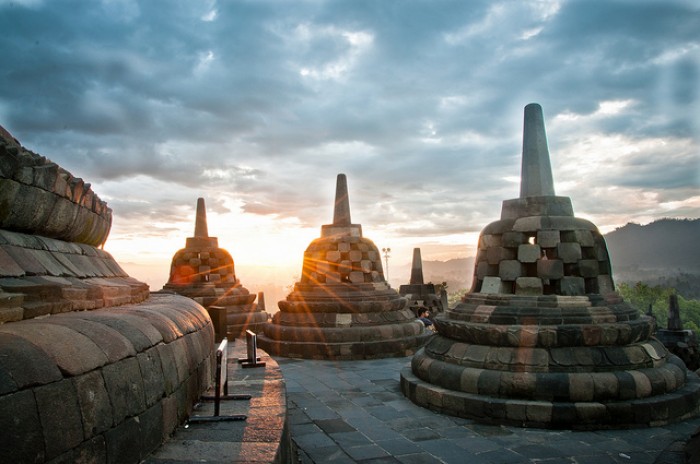
Image credit: Justine Hong
There are three main places to watch the sunrise over Borobudur: Pethuk Setumbu Hill, Dagi Hill and within the Borobudur Park itself. Both Pethuk Setumbu Hill and Dagi Hill offer bird’s eye view of the temple with the menacing Mount Merapi and Mount Merbabu in the background. The 400m tall Pethuk Setumbu Hill is located about 4km from Borobudur or about an hour’s drive from Yogyakarta. The lookout point is a 15 minutes uphill trek from the car park. To reach the lookout point in time for sunrise, you would have to leave Yogyakarta around 4am. Dagi Hill, located within the extensive Borobudur Park, is about 300m west of the Borobudur main temple.
The 300m high hill is believed to be used as a watch tower during the construction of the temple in the 8th century. Today, its slopes are covered with beautiful pine trees with a clearing at its summit. A concrete stairs of 200 steps leads you through the forest up to the clearing. The best season to capture a clear sunrise is during the summer months from June to August when the air is less misty. If you prefer to capture Borobudur covered in mist, anytime will be fine as well.
A sunrise tour within the temple complex provides the best opportunity to capture close up of the temple and its subjects. The morning sun casting its long oblique rays on the temple will bring out the texture of its stone sculptures and reliefs. You will be given a special pass to enter the temple ground early in the morning around 4.30am before the hordes of tourists arrive.
2. Ramayana Ballet
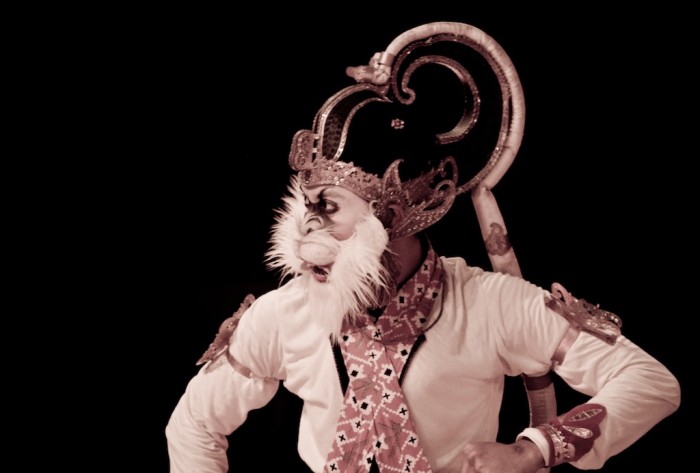
Image credit: triajijati
The Ramayana Ballet is an outdoor dance and theatre performance held against the backdrop of the Prambanan Temple. The play is based on an ancient Hindu love story and follows the tale of King Rama and Princess Shinta, summarised in four scenes – namely the kidnapping of Shinta, Anoman’s mission to Alengka, the death of Kumbakarna or Rahwana, and the meeting of Rama-Shinta. The story revolves around the duties of relationships and the qualities of the ideal wife, king, brother and servant. Gods, mortals, giants, monkeys and beautiful women all come together to tell the colourful story of a courtship punctuated by a kidnapping and battles.
This world class performance is a spectacular visual treat that combines classical dance, music, costumes, lighting and drama. The story presented in this performance is similar to the reliefs engraved on the Prambanan temple. The performance is held in the evening, 2-3 times a week from May to October.
3. River Rafting
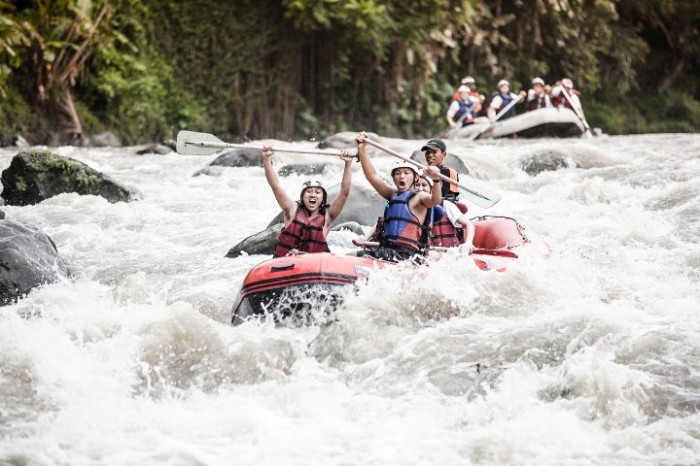
Image credit: Norti Horti
The highlands of central Java is the source of many raging rivers that flow through the narrow gorge of the mountains, to the Java Sea in the north and the India Ocean in the south. Some of the best rafting rivers in Java are found near Yogyakarta. Beginners or families with children can go for Sungai Elo, an easy grade 2-3 rafting river while experts can exhibit their skills at the grade 4 rapids of Sungai Progo. Novices eyeing for a greater adrenaline rush can try the grade 3-4 Sungai Bongowonto.
It will be a test of personal perseverance and team spirit as you paddle your raft down the tumbling river with swirling rapids. The rafting duration varies from 1.5 hours for the easier rivers to 3 hours for the more challenging ones. It is usually done as a half day trip from Yogyakarta so that other activities like the Borobudur tour can be done in the other half day.
4. Jomblang Cave
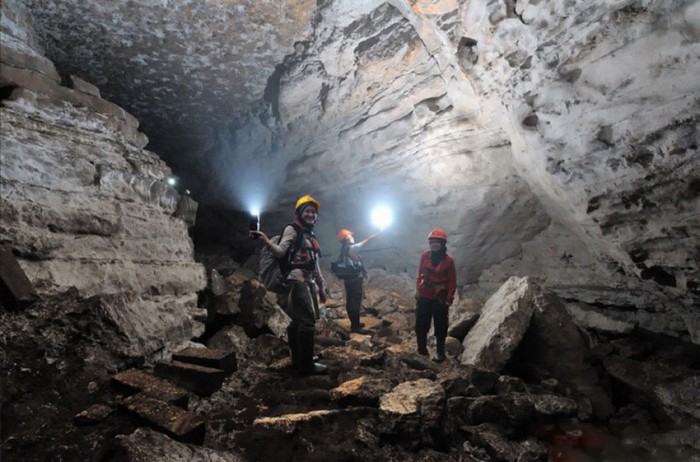
Image credit: jetjeprusyandi
Enter Jurassic Park where mosses, ferns, bushes and even big trees remain untouched and preserved over thousands of years. The Jomblang Cave that leads down to the ancient underground forest is a colossal sinkhole that measures 50m in width and 80m in depth. To reach the bottom of the cave, one has to abseil down via a single rope pulley system. Image hanging by a safety harness in the air while descending into unknown territory. The adventure continues after you touch the ground.
Jomblang Cave is just part of a cave complex in the area. A further 250m along the ancient forest is another gigantic cave called Goa Grubog with a subterranean river that flows out to the sea. Other than the endemic flora, interesting geological structures and adrenaline abseiling, the best highlight is unarguably the heavenly light effect created by the diffusion of sun rays through the sink hole. Jomblang Cave was discovered by the Indonesia’s Indiana Jones, Cahyo Alkantana, an entrepreneur-cum-explorer who stumbled upon the cave in the 1980’s. Since then he has developed it into an eco-adventure site for outdoor enthusiasts.
5. Gumuk Pasir Parangtritis Sandboarding
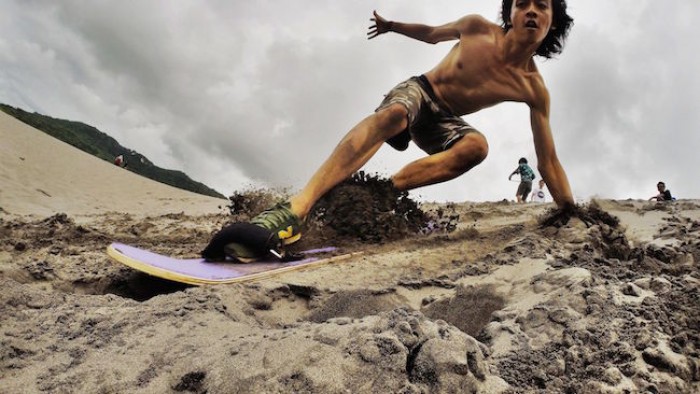
Image credit: wowshack
You heard of skateboarding, wakeboarding and snowboarding. How about sandboarding? Enjoyed since the times of Egyptian pharaohs, sandboarding is a combination of snowboarding, surfing, and skating, only it is on sand dunes instead of snow, waves or streets. The good thing is that you do not need to travel all the way to Egypt to try it out. There are natural sand dunes in Indonesia and they are just an hour drive from Yogyakarta.
The 15km wide mini desert called Gumuk Pasir Parangtritis is formed by wind and water movement which brought volcanic sand from nearby Mount Merapi into the area – a phenomenon which has puzzled geologists for years. Try out different styles of sliding; standing up, sitting down or simply lying flat on your stomach – who knows you might have an innate talent for sandboarding.
6. Timang Beach Cable Car Ride
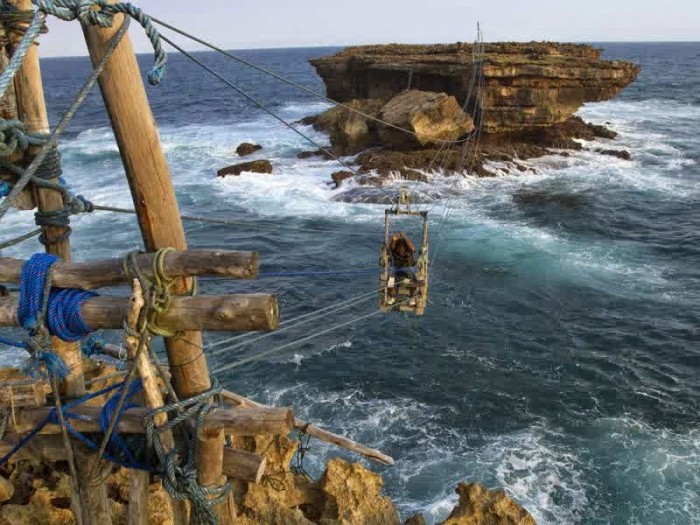
Image credit: fanswebld
Game for an open-air cable car ride across crashing waves? What if the “cable car” is made of wood and operated via nylon ropes instead of steel ropes? The daredevil “cable car” is the only form of transport used by local fisherman to bring them across the narrow strait from the coral hills at Timang Beach to Watu Panjang Island. The rocky outcrop about 20 metres off the shore harbours a rich lobster colony. Upon reaching Watu Panjang Island safely, you will be rewarded with a sweeping view of the beautiful coastline from Krakal Beach to the twin Turtle Island at Nglambor Beach. Timang Beach, which faces the Indian Ocean, is just one of the many beautiful beaches in the Gunungkidul district.
7. Merapi Lava Tour
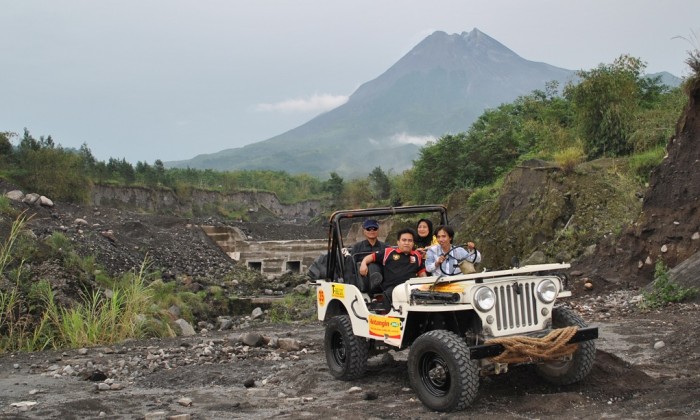
Image credit: java exotica tour
Get an adrenaline rush by standing on the slopes of Merapi – one of the most active and dangerous volcanoes in the Pacific Ring of Fire. Merapi has erupted regularly for more than 10,000 years and is believed to be the cause of the demise of the Hindu Kingdom of Mataram in 1006.
Ride on the legendary Jeep Willys to retrace the barren trail that was created during the major 2010 eruption which devastated a number of villages along its lava path. Along the trail is a truck-sized boulder that was hurled a few kilometres out of the volcano crater during the eruption. Visit an underground bunker which was built as an emergency shelter for villagers in the event of an eruption; it also turned out to be the burial mound for the two guys who sought refuge inside. Witness the horror of the eruption in the Museum Sisa Hartaku (translated as My Remaining Treasure) – a modest museum created from the remnants of a house that was destroyed by the eruption. On display in the house are some of the surviving furnishings including one partially-melted clock with its hands frozen at the time of the eruption.
8. Mountain Trekking for Novices
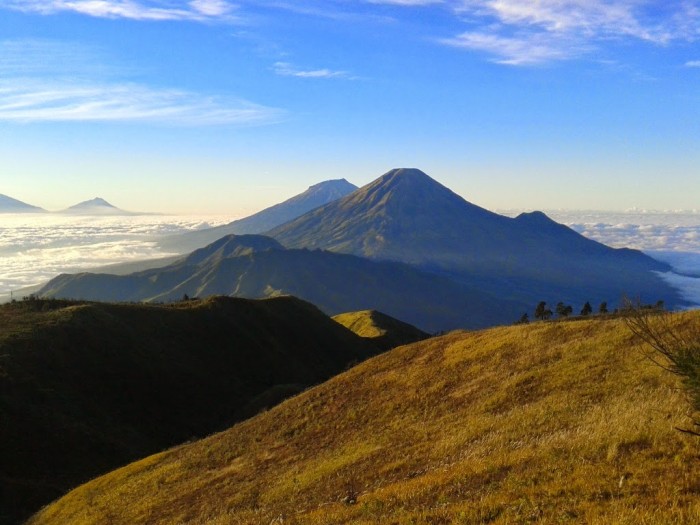
Image credit: backpangineer
At 2565m above sea level, Mount Pra is the tallest mountain on the Dieng Plateau. Mount Prau is named as such because the mountain is shaped like a boat (“prau” means “boat” in the Indonesian language). The mountain which takes about 3 hours to hike from base to summit is readily accessible via a 3 hours’ drive from Yogyakarta, making it an excellent day outing from the city. Unlike most mountain trekking routes, the trail up Mount Pra is along its ridge with
Unlike most mountain trekking routes, the trail up Mount Pra is along its ridge with an unobstructed scenery. During the hike, you will pass by vegetable and fruit plots, savannas blooming with wild daisy flowers and beautiful meadows called Teletubbies Hill. At the summit, you will be rewarded with sweeping views of nearby and distant volcano peaks like Lawu, Merapi, Merbabu, Sumbing and Sindoro and down to the Dieng Plateau itself.
Dieng Plateau which means ‘Abode of the Gods’ in Sanskrit is dotted with many fascinating geological and historical sites like the bubbling Sikidang Crater, the multi-coloured Telaga Warna Lake, and the ancient Arjuna Complex.
9. Kalibiru National Park
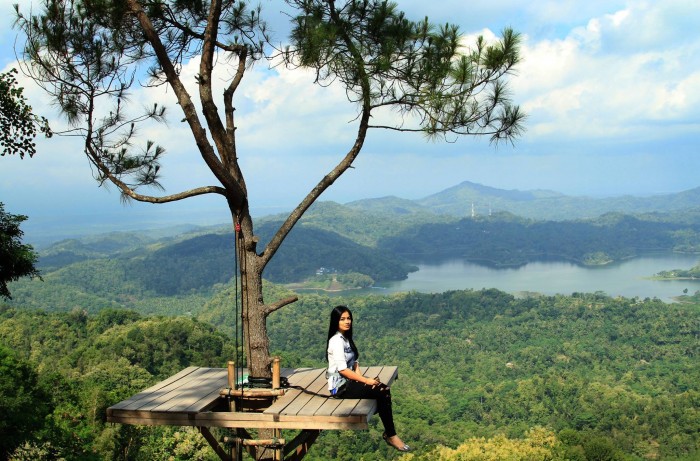
Image credit: kalibiru wisata alam
Kalibiru National Park situated in the Menoreh Mountains is the epitome of eco-adventure destination in Yogyakarta. This park is most famous for its unique lookout points – wooden platforms built on top of trees – where you can capture Nat Geo worthy pics of the tranquil Waduk Sermo reservoir in the midst of lush vegetation with pretty hills and endless sky in the backdrop. You can also stroll around the various trails to enjoy the fresh mountain air and greenery or challenge yourself in some adventure games like rock climbing, tightrope walking or flying fox.
Also read: Top Things to Eat in Yogyakarta Including 5kg Meatballs
10. Mangunan Fruit Garden
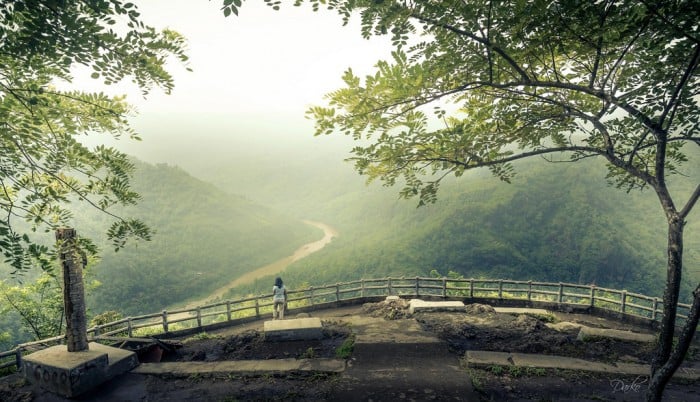
Image credit: widarko hartono
Mangunan Fruit Garden is an up and coming eco-nature hill resort in the vicinity of Yogyakarta. In additional to its refreshing atmosphere, it has one of the best sunrise views in the region. At dawn, the heavy mist casting over the forest canopy creates a magical phenomenon that can be described as a sea of clouds. As the sun rises, the mist slowly disperses to reveal the meandering Oyo River on the valley below. It also offers an excellent lookout point of the Parangtritis beach with the Indian Ocean in the background. You can also try out the various fruits grown in the orchard like durian, mango, rambutan, orange, mangosteen, duku fruit, longan, guava, guava, star fruit, jackfruit, snake fruit and sapodilla.
11. Ullen Sentalu Museum
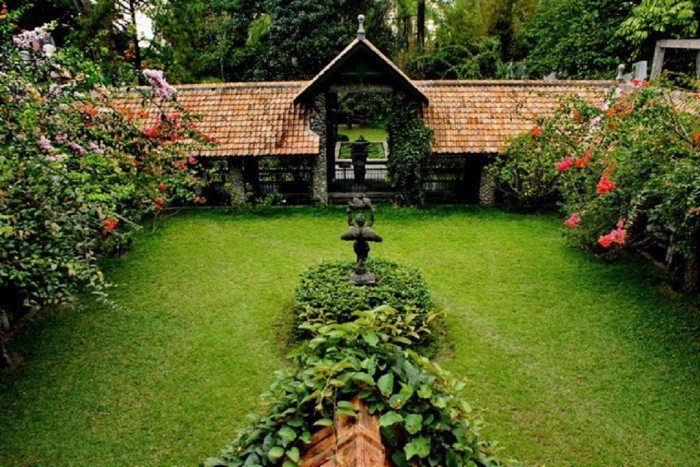
Image credit: thedustysneakers
Museum-lovers will not want to miss out the Ullen Sentalu Museum, voted by many critics to be the best museum in Indonesia. The privately-run museum houses a vast array of artefacts that illustrates Javanese history from the era of the powerful Mataram Kingdom that built the world famous Borobudur.
The physical setting of the museum – a charming colonial stone building surrounded by well-tended gardens in the midst of pine and cinnamon forest – is enough to set it apart from other museums in the country. The sprawling maze-like building consists of many interconnecting small galleries above ground and tunnel-like galleries underground. The collection includes antique furniture, batik, topeng, kris, wayang kulit puppets, sculptures, paintings of kraton princesses and sultans (each with a story of its own), handwritten letters, love notes and black and white photographs of the royal family. The visit usually starts with an informative guided tour and ends with a serving of Ratu Mas, a secret herbal cocktail that is believed to bring health and beauty.
Also read: Jakarta to Yogyakarta by Train: An Easy Guide for This Scenic Train Journey in Indonesia
12. Foodie
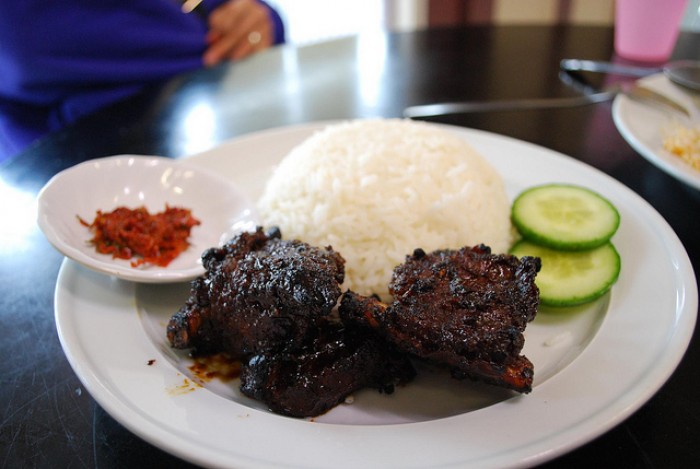
Image credit: Alpha | Flickr
Yogyakarta is considered by many to be the culinary capital of Indonesia. Its most representative cuisine is Nasi Gudeg, a rice dish made from young unripe jackfruit stewed for several hours in palm sugar and coconut milk, usually served with egg and chicken. Yogyakarta is sometimes nicknamed “Kota Gudeg” (City of Gudeg). Gudeg Yu Djum located close to the Sultan’s Palace serves one of the best Gudeg in Yogyakarta. The stalk which is now helmed by its 4th generation also offers diners an opportunity to look at how Gudeg is made in its kitchen.
The runner-up after Nasi Gudeg is probably Brongkos, a sweet and spicy rawon-like beef brisket soup cooked with spices, tolo and red beans. Warung Handayani located at Alun-Alun Kidul is the crown of Brongkos in town. Fried chicken diehards should not miss Ayam Goreng Kalasan – fried pre-marinated with coconut milk – reputed to be tastier than Popeyes. Street food lovers will find their paradise in Jalan Malioboro with street eateries selling local snacks and delicacies like satay, wedang ronde (glutinous rice ball in ginger soup), kelapa muda (young coconut drink), rujak es krim (ice cream rojak), etc. Café-hoppers will also not be disappointed as cafes selling coffee and gelato are big businesses in Yogyakarta.
Contributed by I Wanna Travel





